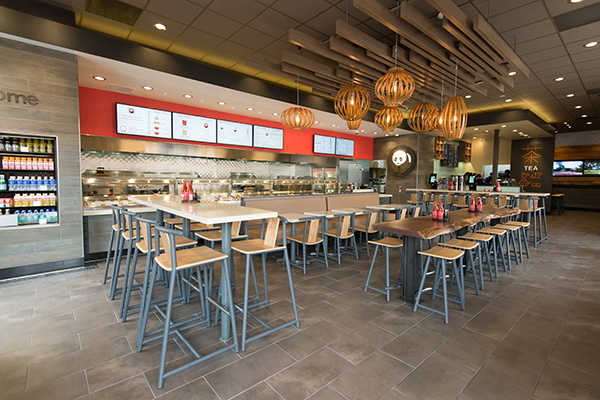Restaurants also need to monitor the temperature of the water that leaves the building via the sewer system. "Most municipalities won't let you dump water that's more than 140 degrees F down the drain," Benedict says. "So restaurants might need a drain tempering kit to bring the water down to temperature. We recommend using copper on those drains because if it is not the right pipe, it could melt. Yes, copper is pricier, but it's tried and true and will handle the water better. Spending those few extra pennies can go a long way."
Benedict also recommends running all restaurant sinks and drains through a grease trap, even if the sink is not intended for use as part of a cooking or prep application because you can't always predict what staff will do. "Some utility sinks might not go through a grease trap because the thought is there no grease in that water," he adds. "But depending on where you are, that can be a mixed bag."
Equipment Matters
The type of equipment a restaurant uses will also affect its plumbing system. For example, some restaurants use water-cooled ice machines and refrigeration, which can be costly to operate. Switching to air-cooled ice machines and refrigeration not only reduces water consumption but it can also lower the amount of water a restaurant expels through its sewer connection. "If you have escalating water costs, moving to air-cooled systems will provide a significant savings," Delagah says.
Dishwashers represent another key opportunity to lower water consumption. The easiest way to begin this process is to research Energy Star-rated dishwashers. But don't stop there. "Sometimes you have to dig a little deeper through the model specification sheets as dishwashers are only rated for their rinse-water consumption. Avoid units that use cold water to knock down the steam generated after a high-temperature rinse cycle since these units essentially double the water use of the machine. Dishwashing is essentially erosion by water. So you need to understand how they are achieving this," Benedict says. "Take into consideration what you are washing: lots of china and glassware vs. trays can make a difference in what you choose."
In terms of efficiency targets, Delagah suggests starting with door-type warewashers that use three-quarters-of-a-gallon of water per rack and conveyor units that use a half-gallon or less of water per rack. "The dishwasher market is mature with water-efficient machines," he says. "Those are good areas for you to look to set your goals when specifying equipment. Be careful: An old conveyor dishwasher can use up to 75 percent of the hot water used in your existing facility, so it is important to replace old units."
Pre-rinse spray valves represent another potential area for savings. Some units use up to 5 gallons of water per minute, which can translate into an annual operating cost of $1,500, according to the FSTC. Replacing them with high-performance units that use .65 gallons per minute may lower costs by up to $1,000 annually. "We can still maintain pre-rinse performance at less than a gallon," Delagah adds.
Proper maintenance of warewashers helps to ensure that these units function as efficiently as they promise. "It is easy for those machines from a lack of maintenance or from malfunctions to no longer function to specification. And there's no way to know this," Delagah says. "So a good tip is to add a water meter so you can keep track of water use. Sub-metering of a dishwasher can save a lot of money. Some larger machines might have two lines coming in, one for the wash tanks and one for the rinse, and you might want to meter both lines to see if one is causing you more of a problem than another. If water savings are a priority, it starts with the dishwasher. Have a dedicated staff member that oversees the equipment and sanitation room operation."
In addition, restaurants should consider replacing older, less-efficient equipment. For example, connectionless steamers and high-efficiency combi ovens use less water than other units. "See what you have and make the changes that will give you immediate savings," Delagah says.
Dipper wells represent one example where restaurants can make an immediate impact. "You don't need them," Delagah says. "This is an established item but you can do the same type of work without a dipper well. It is just continuous water running down the drain. By using alternative utensil holding practices we can get 90 percent water savings in some instances."
Don't be afraid to get creative with the restaurant's equipment package, Benedict adds. "Try to work with equipment that can perform multiple functions. For example, locate prep sinks where you can use them for more than one back-of-the-house department."
And be sure to get the right size equipment for the right application. "That's where the designer needs to look at menu, table turns and more," Benedict says.
Sub-Metering Magic
For restaurant chains that want a more detailed look at their water consumption, Delagah suggests sub-metering all points of use. This will help the company get a better handle on where and when their operations use water. "If you are big enough, do your own program. Otherwise, hire a consultant to conduct a long-term study of your restaurant's water usage," he says. "For example, night-time cleanup practices can differ from one facility to the next. How they use the three-compartment sink and clean the floors can affect that water use significantly."
If sub-metering is not an option, Delagah suggests restaurants work with their utility provider to add a smart water meter to get a more detailed look at their water use in 15-minute increments instead of readings once a month or bi-monthly.
The only step a restaurant should not take? Sit idly by and do nothing. "Everything is rising, but water costs are going up faster than other costs," Delagah says. "In restaurants in many parts of the country, the water and sewer costs associated with hot water surpass the energy costs to heat the water. The generation that thought water was cheap and plentiful is gone, but water use and cost are not as big of a consideration as they should be."



